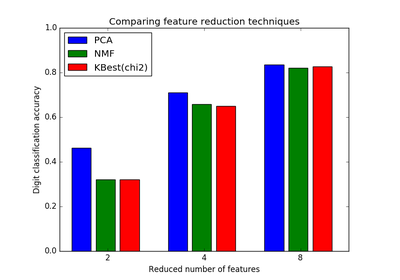sklearn.feature_selection.SelectKBest¶
-
class
sklearn.feature_selection.SelectKBest(score_func=<function f_classif>, k=10)[source]¶ Select features according to the k highest scores.
Read more in the User Guide.
Parameters: score_func : callable
Function taking two arrays X and y, and returning a pair of arrays (scores, pvalues) or a single array with scores. Default is f_classif (see below “See also”). The default function only works with classification tasks.
k : int or “all”, optional, default=10
Number of top features to select. The “all” option bypasses selection, for use in a parameter search.
Attributes: scores_ : array-like, shape=(n_features,)
Scores of features.
pvalues_ : array-like, shape=(n_features,)
p-values of feature scores, None if score_func returned only scores.
See also
f_classif- ANOVA F-value between label/feature for classification tasks.
mutual_info_classif- Mutual information for a discrete target.
chi2- Chi-squared stats of non-negative features for classification tasks.
f_regression- F-value between label/feature for regression tasks.
mutual_info_regression- Mutual information for a continious target.
SelectPercentile- Select features based on percentile of the highest scores.
SelectFpr- Select features based on a false positive rate test.
SelectFdr- Select features based on an estimated false discovery rate.
SelectFwe- Select features based on family-wise error rate.
GenericUnivariateSelect- Univariate feature selector with configurable mode.
Notes
Ties between features with equal scores will be broken in an unspecified way.
Methods
fit(X, y)Run score function on (X, y) and get the appropriate features. fit_transform(X[, y])Fit to data, then transform it. get_params([deep])Get parameters for this estimator. get_support([indices])Get a mask, or integer index, of the features selected inverse_transform(X)Reverse the transformation operation set_params(\*\*params)Set the parameters of this estimator. transform(X)Reduce X to the selected features. -
fit(X, y)[source]¶ Run score function on (X, y) and get the appropriate features.
Parameters: X : array-like, shape = [n_samples, n_features]
The training input samples.
y : array-like, shape = [n_samples]
The target values (class labels in classification, real numbers in regression).
Returns: self : object
Returns self.
-
fit_transform(X, y=None, **fit_params)[source]¶ Fit to data, then transform it.
Fits transformer to X and y with optional parameters fit_params and returns a transformed version of X.
Parameters: X : numpy array of shape [n_samples, n_features]
Training set.
y : numpy array of shape [n_samples]
Target values.
Returns: X_new : numpy array of shape [n_samples, n_features_new]
Transformed array.
-
get_params(deep=True)[source]¶ Get parameters for this estimator.
Parameters: deep : boolean, optional
If True, will return the parameters for this estimator and contained subobjects that are estimators.
Returns: params : mapping of string to any
Parameter names mapped to their values.
-
get_support(indices=False)[source]¶ Get a mask, or integer index, of the features selected
Parameters: indices : boolean (default False)
If True, the return value will be an array of integers, rather than a boolean mask.
Returns: support : array
An index that selects the retained features from a feature vector. If indices is False, this is a boolean array of shape [# input features], in which an element is True iff its corresponding feature is selected for retention. If indices is True, this is an integer array of shape [# output features] whose values are indices into the input feature vector.
-
inverse_transform(X)[source]¶ Reverse the transformation operation
Parameters: X : array of shape [n_samples, n_selected_features]
The input samples.
Returns: X_r : array of shape [n_samples, n_original_features]
X with columns of zeros inserted where features would have been removed by transform.
-
set_params(**params)[source]¶ Set the parameters of this estimator.
The method works on simple estimators as well as on nested objects (such as pipelines). The latter have parameters of the form
<component>__<parameter>so that it’s possible to update each component of a nested object.Returns: self :





